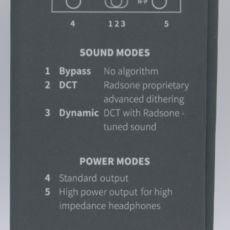
disclaimer: The HUD100 was sent by Radsone for the purpose of this review. I have no financial interest in Radsone, nor have I received any renumeration for this review. If you have an interest in purchasing the HUD100 or other Radsone products, check out their website. To purchase an HUD100, visit RadSone’s new store directly. Also worth noting, the price has dropped since we originally received the review sample with the HUD100 now selling for $139.99.
Packaging:
The packaging of the HUD100 is deceptive as the picture on the front of the box belies the size of the device. The lift-top style box has the photo on the front and data on the sides of the box. Lifting the cover reveals the instruction booklet on top and then the DAC in a foam surround. Under that, we have a small leather case a 1 meter usb cable and a 10 cm usb cable. The only thing that is missing is an OTG adapter for use with android phones. With IOS the CCK is required so the standard cable works fine, but with android an OTG is required so it would be nice to have in the package rather than having to find one elsewhere.








Build:
This thing is small, like smaller than you probably think even looking at the pictures, thus the quarter in the photos. The unit is about the same height and about two quarters wide and 1/3 of a quarter thick. In inches, that is 1.75 wide, 1.25 tall, and 1/3 of an inch thick. Construction is all metal with controls on top and bottom and sides slick save for an LED hidden in one side. The Top has two 3.5mm jacks for different impedance and a 3 position switch between while the bottom has a USB-C input and a switch used for firmware. The unit has little heft, but feels very solid with no play in the connectors and very positive clicks to the switches.






Internals:
The HUD100 packs a lot of tech into its tiny package with an AK4377 DAC, and arm cortex cpu, mems oscillators to reduce jitter compared to standard crystal oscillators. The usb-c input port supports up to 32/384kHz for PCM and DSD128 depending on the source and driver in use. Radsone officially supports IOS (10.3.3 and above), Android (6 and above), Mac Os (10.10 and above), and windows (7 or newer). The HUD100 was discovered on all my device types without need of a driver, but the driver provided on the Radsone website does allow Windows to use the full capability of the device while it is limited to 24/96 without it on my system. The two output jacks on the HUD100 offer .914 V rms for the standard port and 2.26 V rms for the High-power port. I found my HD6xx ran fine off the standard power port while my HD800s needed the High power port to have enough headroom when using the little dongle.
Controls:
The HUD100 is fairly straight forward and realistically you could simply plug it in via USB and plug a headphone into it and go. There are two buttons, one between the two headphone jacks, and the other on the back side next to the USB port. The switch nearest the USB port is used only for firmware updates and at the time of review no such release existed so I can’t speak to ease of use on that one. The other switch (the one on the top between ports) is a 3 position switch that controls the tuning. With the switch in its left most position (nearest the standard output), the system is in bypass mode and no tuning is applied. In the center position, the device is in DCT mode which Radsone lists as processing the signal for a well-dithered analog like sound. In its right most position (nearest the HP output), the device is in Dynamic mode which provides a more powerful sound while retaining balance according to Radsone documentation.
A single LED in the center of the blank side of the box indicates sample rate with green representing 44.1kHz, blue 48kHz, aqua 88.2 -96kHz, Red 176.4-192kHz, Yellow 352.8-384kHz and white for DSD. I had no trouble distinguishing white, and the lighter blue that can be an issue with some of the cooler leds on the market.
Sound:
First off, the modes do make a difference with the bypass being nearly linear with just a slight bump in the upper-mids/lower-treble to my ear. The DCT mode does produce a warmer tone with a slight emphasis to the mids and a bit more sparkle than the bypass comparatively. The Dynamic mode is a more V shaped tuning with emphasis on the sub-bass and lower mid bass and again on the treble region. I found detail to be good in all three modes and found that depending on the source material in use I could find myself preferring different settings. For pop/rock, the dynamic is fun, while for string quartet the bypass or DCT are preferable, and for full orchestral works, I’d choose the bypass every time. There is also a notable difference in the two outputs. For me it was easier to discern the differences in output power by looking at the noise floor of the two options. For sensitive in-ears, the standard output has a jet black noise floor while the High power output has a bit of hiss when paired with the same. On full size cans, the High power output provides more headroom although many low impedance cans may work just fine using the standard. It is also worth noting that the HUD100 does have its limits, things like the He-560 or T50rp that are famed for their power handling are both a bit too much for the HUD100, but things like the HD700 and even HD800 are within the High-power outputs wheelhouse.
Comparisons:
Ikko Zerda – Probably the biggest difference here is that the Zerda forces you to pick either usb or lightning up front and you cant have both unless you buy two. Both have good sound, but the HUD100 is a bit more versatile with its dual outputs and tuning modes. Output power is a bit higher on the high power output while the low power side is a bit lower than the Zerda’s output and may make the HUD100 a bit more useful with high sensitivity models to avoid hiss.
Hidizs Sonata S3 – I found the HU100 to be considerably more potent when compared to the S3. This one is a no brainer as build, power, sound, and versatility all favor the HUD100. The S3 is a good bit cheaper of course and has a smaller form factor which may also play into the argument for some.
Audirect Beam – Here we have a similar form factor to the HUD100 with a removable cable, DSD support (including 256 which the HUD does not support). The Beam also offers device controls on board while the HUD100 relies on the parent device to provide the same. Output power favors the HUD100, and tuning options do as well. During testing the beam was easier to knock the cable lose on in pocket and lose signal during playback. Also while my personal Beam has been solid, reports of build issues are common enough that I have some concern about long term durability. This is a much closer fight, but between durability concerns, price, and tuning make me lean toward the HUD100 as the more solid option.
Dragonfly Cobalt – So does spending this much more get you much more as a result? Short answer, nope it doesnt. The Dragonfly is limited to 24/192, build quality is much better on the HUD100 as the plastic shell has considerable slop to it on the dragonfly. Sound is where the dragonfly does well with good linearity and a very crisp sound. I do think the detail is slightly better, but lacking the tuning options of the HUD100 which give the HUD the ability to adapt a bit more than the dragonfly. Unless you just have to have MQA support, you can save a couple hundred dollars by looking into the HUD100 first.
Conclusions:
There is an odd dichotomy in the market today, we have phone vs DAP, TWS vs dongle DACs, and streaming vs local files all going on in the portable, daily commute kind of space. The HUD100 is Radsone’s take on the dongle for those who want a small DAC/amp that packs a lot of function into the package. It is tiny, but still provides more output power than typical for dongles and more versatility with its dual outputs and tunable signature. While the HUD100 was never meant to be a desktop DAC/Amp, it works well enough with most full sized cans to be a good option for something that goes in an office drawer when not in use. The HUD100 gives the purchaser a lot for their dollar, tunable sound, both high power and low noise floor options, a tiny form factor that stashes easily when not in use, and construction that should stand the rigors of the daily commute with no ill effects. While the market is certainly crowded for dongles, the HUD100 does a lot to stand apart from the crowd and deserves your attention. I guess it shouldn’t surprise me that the company that developed probably the best 1st gen bluetooth adapter in the ES100 has now worked the same magic on the dongle. It might just be these Radsone boys know a bit about what they are doing.












